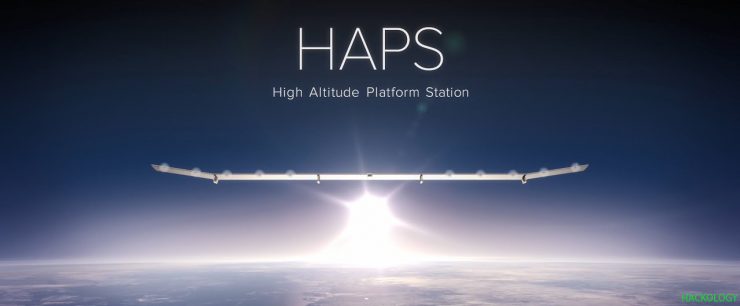Facebook might have succeeded in beaming broadband internet from high altitude using drones with the help of its Aquila project but that project has been permanently closed since 2018. HAPSMobile, a Japanese venture, has recently succeeded in successfully using similar concept with advanced technology to achieve the same goals. The company launched a massive glider powered by solar panels, to an altitude of 62,500 feet for a test flight of 20 hours and beamed internet for 15 hours attaining transfer speeds of 1gbps, somewhere in the stratosphere of New Mexico just a few days ago.
What is HAPS
Located in the stratosphere, HAPS (High Altitude Platform Station) is a telecommunication platform. HAPSMobile aims to build a next generation tech that will enable telecommunication in space. Throughout the year, the weather conditions are mild with minor changes in wind, enabling stability in flight of HAPS. HAPS is closer to the earth as compared to satellites, so this will provide low-latency communications.
HAPSMobile is an affiliate company of Softbank that has planned to function the HAPS networks. Softbank was also the first company to make the first emoji. This company is known for developing unmanned solar powered aircrafts used for telecommunications in the stratosphere, called the Hawk30 a.k.a Sunglider.


With Loon LLC as a strategic partner of HAPSMobile, the unmanned 262 feet wide aircraft while withstanding strong winds hosted video calls with a handful of internet pioneers such as Vint Cerf, who is known as the “the fathers of the Internet” and few others around the globe. After the successful test flight, HAPSMobile spokesperson said in a press release
Using the stratosphere for the mobile Internet is going to be the next most innovative challenge, and it will add to the existing and achieved innovations of the Internet
How Does Hawk30 Work
According to HAPSMobile, the payload technology used in the test flight was the first of its kind for an unmanned fixed-wing aircraft HAPS to distribute LTE coverage. The payload, with the help of MIMO (multiple input multiple output) technology, enabled the LTE connection to be broadcasted for 15 hours in the 20 hour duration of the aircraft’s test flight. The tailless aircraft is a 262 ft (78 m) span flying wing with 10 electric-driven propellers. Orbiting at 62,500 ft (19 km), it is solar-powered by day and battery-powered by night to stay aloft for up to six months initially. Service life could be two year and time on station around 1-2 months with experience. Remotely piloted for the ascent and descent, Sungliger will be autonomous once cruising in the stratosphere, with a cruising speed of 59 kn (110 km/h).


Sunglider – A Success Flight
The payload enabled video calls via smart phones during the flight using the frequency as that of smartphones. Payload’s performance was up to the mark, keeping in the atmospheric conditions of the stratosphere. Apart from beaming high speed internet coverage of 1gbps, HAPSMobile was also able to conduct some basic measurements related to stratosphere-to-ground radio wave propagation data that will be of great help to the ITU (International Telecommunication Union) Radio communication sector. Using the insightful information and data collected from the test flight, HAPSMobile and Loon together with ITU will further progress the work done on Hawk30 / Sunglider. In addition to this, the successful test was also able to provide insights on how this could be used in natural disasters and other life changing technologies.


Future of Hawk30 and Drone Internet
The massive 262 feet wide solar powered glider was able to propel forward and upward with the immense help of 10 electric motors powering it, and while the test flight was only a few hours, this drone can fly for months at a time, which is quite longer than the test flight duration. The unmanned drone was able to fly at an elevation of 19 kilometres , placing it above an average aircraft, and is also able to transport an impressive amount of 68 kilograms of payload.
Similar to the SpaceX project, HAPSMobile aims to connect people all around the globe with the help of new and innovative technology. HAPSMobile has uploaded a video showing all the stages of their test flight, the video is kind of dull but serves it’s purposes just fine.
The applications and use case scenarios are endless, from providing internet to remote areas where conventional internet means can not be expanded due to infrastructure limitations to places of natural disasters. Drone internet and satellite internet can be an easy and cost effective alternative to conventional internet delivery methods.
Drone vs Satellite Internet
Even though this is definitely an exciting and huge step in the field of unmanned aircraft, it is not the best and most sustainable option for global internet connectivity (yet). Elon Musk’s upcoming Starlink project will be a game changer and will definitely mould the shape of industries. Starlink project aims to provide low cost internet connectivity to remote locations around the world. Starlink, a project of SpaceX, consists of mini satellites that will orbit the lower atmosphere of the Earth. SpaceX aims to have as many as 12,000 satellites in the lower orbit of the Earth. Each satellite will weigh approximately 227 kilograms. The satellites will beam internet through the vacuum of space which is roughly 47% faster than fiber optic cables. These satellites are meant to carry huge amounts of data and transmit it to any place on Earth especially in hard to reach areas, by being in the lower orbit of the Earth. This shows that satellite communication will do wonders and is the way ahead.
HAPSMobile Press Release Coincidence
- HAPSMobile did a test flight on 23 October 2019 and the flight was reported by the company on 8 November 2020
- HapseMobile did their latest test flight on 23 September 2020 and the flight was reported by the company on 8 October 2020
It can be a mere coincidence or is there some relevance of figure 23 and 8 ? I have asked HAPSMobile and will update if I get a word from them on this.
Conclusion
Drones have a very high maintenance upkeep once compared with satellite which are more or less maintenance free. Drone technologies are advancing rapidly and such positive uses of drone technology is very much welcomed as up till now the word ‘drone’ is linked with military related tasks only i.e. UAS , UCAV etc. Successful test flights of Hawk30 with their planned endurance of few months, will eventually enable autonomous flights for years unlocking a new potential and providing greater redundancy in internet coverage.












[…] What do you think of this and it is certainly more feasible if compared with Drone Internet. […]